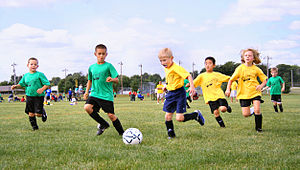Physical literacy
Originally founded by Levins, Lewotin, and Burkitt this philosophical view looks at how learning should be seen as interaction with situations and settings with other people.
Some of the main categories include;[6] There are a variety of movement patterns that can become more specialized to attend to specific sports and activities.
In Great Britain, several local authorities have adopted it as an overall guiding principle for their work in school-based physical education.
In India this principle has been adapted by Sportism for training the Indian kids on the basis of Physical literacy concepts.
[7] This section is focused on developing milestones for children that engages a new individual in fun and basic physical activity.
A child and toddler are more likely to enact activities into a daily routine if it is fun and basic in terms of skill level and equipment required.
Some of the main goals for this stage include: Near this age, many of the habits and abilities have been developed at least on a basic level.
Some key reminders at this stage include: It becomes even more important for children to develop strong habits at a young age for physical literacy to come seamlessly when entering adulthood.
Similar to young adolescents the Government of Canada outlines some of the best guidelines to maintain physical literacy when entering adulthood.
The Four Environments To develop physical literacy children should learn fundamental movement skills and fundamental sport skills in each of the four basic environments: People with Disabilities Everyone deserves the right to have opportunities to develop physical literacy.
[11] There are both many opportunities and challenges that people with permanent disabilities experience in pursuing sport and physical activity.
As a result, many resources have been created to support coaches, educators, recreation leaders, health practitioners, and parents in accommodating the needs of all participants to have increased physical activity and positive experiences.
[14] Many sports leagues and clubs have started implement physical literacy plans into their training regimens.
[16] A good way to create a supportive environment at home is to have family based activity goals.
Whichever method one chooses to monitor physical literacy, it is crucial to keep an ongoing record of evaluations.
[14] This holistic approach encourages individuals to keep going by being able to look back at where they started, and track their progress along the way.
By incorporating physical literacy assessment into educational settings not only benefits individuals motivation and confidence, but also encourages a lifelong active lifestyle.
[13] A benefit of incorporating physical literacy assessment into healthcare settings is financial savings; country's like Australia predict that the incorporation of physical literacy into their society will save their healthcare system billions of dollars in the future.
Because of this major countries like Canada, Australia, the UK, and New Zealand have been investing hundreds of millions of dollars in programs that promote physical literacy through schools, community centres, and sports clubs.
[15] These technologies are readily available and offer relatively cost-effective ways of detailed assessment in physical literacy initiatives.



